Home » Home Decor » How to build a small garden
Don’t get disheartened by your small outdoor space if you plan on developing a garden. With just a small nudge to the creative genius within, you can easily build a small garden for your home. And with only the bare-minimum of effort – as we’ve written down below!
Why build a small garden?
Many people take up gardening as a hobby these days. It is a good stress-buster, no doubt, and a productive activity. For your home, well-done gardens (irrespective of size) add an aesthetic appeal to the exterior. And if you ever plan to sell your home or put it up for rent, they undeniably raise its market value.
Gardening in a limited space
Converting a small outdoor patch into a thriving garden may initially seem like a daunting task. But once you go through the process, you’ll know that it is actually easier to create an eye-catching garden in a limited space. You can build a small garden without trouble if you apply a few simple design principles.
These are applicable to any area-size of land available, but work particularly well for limited space gardening.

Garden design principles 101
The following design principles help to add balance, organisation, and an aesthetic appeal to a small garden:
Scale
First, we need to discuss the concept of scale.
Very simply, scale is the size of one thing in comparison to that of another. For your small-sized garden, identify the largest body around and adjust its scale in ratio to it.
Consider this:
In your outdoor space, the structure of your house is the largest body around. So, for starters, you will need to compare the size of the plants, or any other constructions in your garden, with the general house body.
A well-defined scale helps to set the illusion of a large garden within a limited space.
To achieve this effect, we recommend planting a couple of large plants. These will act as your focal point. Around this point, you should root plenty of medium-sized plants. Complete the look with a few dwarf species.
Using this method balances the appearance of your small garden. It also makes the plantations appear well-structured.
Texture
Visual texture plays an important role in interior design. Similarly, it is beneficial to garden design as well. And it is most prominent in the leaves than in the shape of a plant.
Plants with medium-textured leaves are commonly used in gardening. To boost the texture element further, consider using coarse and fine-textured plantations. Your eyes will thank you for it.
Leaves with coarse textures make a garden appear bolder – forcing the eye to focus on certain points.
Leaves with a fine texture, on the other hand, blend in. As such, they cause the viewer’s glance to switch from one point to another with ease.

Repetition
It seems like a good idea to introduce variety to your small garden. But you must be careful not to stuff, and overwhelming the eye while you’re at it.A disorganised variety of plantations is counterproductive to the element of balance we mentioned previously.
To resolve this problem, apply the principle of repetition. Choose any one design element to repeat. For example, focus on a certain shape, colour, pattern, texture, or plant variety.
Focus
Depending on your garden’s size, you should try to maintain a few focal points. Having even one works well for a limited space. But if you have a lot of gardening space, don’t litter it with too many focal points.
As in everything concerned with garden maintenance, moderation is key.
The job of a focal point is to bring pause to the eye. Additionally, it should bring about some appreciation for a particular corner. This is why too many of these design features tend to cause unwanted disruption.
Many homeowners choose installations like fountains, garden walls, ponds, and bridges as focal points. Small gardens often don’t accommodate such constructions. Fortunately, plants, as aesthetic wonders in themselves, are quite good for this purpose.
One trick to create focal points out of plants is to lead the viewer’s eye with medium or fine-textured varieties. And to position the course-textured species in the focal area.
You can also make do with ‘blooming’ plants. These bring a pop of colour to your small garden.

Small Garden Ideas on a budget
Homeowners find gardening expensive – even on a small patch of land. So if you’re looking for small garden ideas on a budget, lend your hand to some do-it-yourself (DIY) techniques.
Try the following:
- Put that collection of spare plastic bottles to work, instead of using actual plant pots
- Use slabs from old wooden crates to construct a nifty fence
- Don’t buy plants or seeds from nurseries. Try growing saplings from the cuttings exchanged from friends or neighbours

Gardening is a healthy activity despite the time, effort, and money invested in it. Even limited space gardening takes some getting used to. But in the end, it is totally worth it.
A well-designed small garden will boost your home’s curb appeal, offer a nice exterior corner to relax in, and add value to the property.
Do you have any of your own small garden ideas on a budget to share? Do share them with us in the comments section below.



